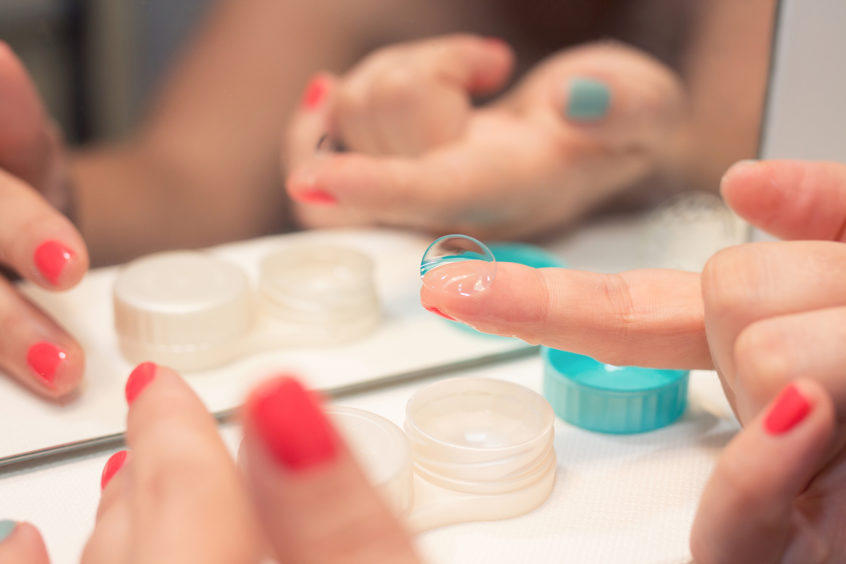Wearing contact lenses really simplifies life for those with impaired vision. These simple medical devices promote a wider range of sight, lessen visual obstruction, and provide more clarity. You can see comfortably and aren’t constantly wondering, “Where did I put my glasses?” or whether your spectacles are too loose to wear on that roller coaster. You don’t have to think about putting on a pair of nonprescription sunglasses and being unable to see clearly. Best of all, contacts don’t fog up!
According to the CDC, over 40 million Americans wear contacts daily. Here is what you should know about choosing a contact lens and taking care of them.
QUICK FACTS FROM Centers for Disease Control and Prevention
August 2017
| People in United States who wear glasses | 57% of population |
|---|---|
| People in United States who wear contacts | 12% of population |
| People in United States who wear contacts and glasses | 9% of population |
| Adolescents 17 or younger who wear contacts | 3,600,000 (14.5% of age group) |
|---|---|
| Young adults between 18 and 24 wear contacts | 7,500,000 (24.4% of age group) |
| Adults age 25 and older wear contacts | 33,900,000 (15.5% of age group) |
What should I know about buying contact lenses?
- Having the appropriate prescription for your lenses is imperative. A lens that fits too tightly can hinder your eye’s ability to access oxygen. An improperly fitted lens can stick to your cornea and cause keratitis or corneal ulceration.
- Use only up-to-date prescriptions. Contact lens prescriptions are not interchangeable with glasses prescriptions. See your eye doctor annually to ensure getting suitable contacts for your eyes.
- Follow the usage guidelines for your contacts. Some can be worn overnight, some can be for daily use, and some can be worn for seven to 30 days. However, resting your eyes with a few contact-free hours daily is recommended.
- Replace your storage case at least once every three months to prevent any bacteria and germs from causing your eyes inflammation or infection.
I’ve heard about all sorts of lenses – daily, rigid, soft, etc. What are the differences? Which should I choose?
- Rigid gas permeable (RGP)
- Durable plastic that resists buildup and debris
- Clearer vision
- Less expensive than others
- Possibly less comfortable and harder to adapt to using
- Only few can be worn overnight
- Soft contacts
- Comfortable, flexible plastic
- Easier to adjust
- Allow breathability
- Can be worn overnight
- Daily
- Used once and discarded
- Must be cleaned if necessary to reinsert
- Extended wear
- Can be worn overnight
- Can be used continuously for one to six nights
- Can be used up to 30 days with rest periods
- Toric
- Used to assist with astigmatism correction with particular shape
- Creates focus increase or decrease throughout the eye plane as per individual
- Have thin and thick areas for personalized focus
- Assists with multiple types of vision corrections
- Spherical
- Adjustment is same throughout and consistent
- Used for farsightedness or nearsightedness
- Multifocal/bifocal
- Adjustment is not the same throughout the lens
- Used for farsightedness and nearsightedness
- Monovision
- One contact in one eye for close vision, contact in the other eye for distance
- Created to help aging eyes
- Can assist with depth perception issues as well
How do I insert the lenses?
- Wash your hands before inserting your contacts. Any substance that is on them can get into your eye and irritate or scratch your cornea. Using a gentle soap, fragrance-free soap. Hand sanitizer is not recommended because its drying properties and stinging scent.
- Examine the lens for any splits, cracks, dirt, and debris. Be certain that the lens is in one piece, not ripped or torn.
- Place the lens in your palm. Use your finger to lift the lens to your eye.
- Hold your eyelids open with your other hand.
- Look up and gently press the lens into the white of your eye.
- Blink a few times to get the lens in the right place to focus.
What are good practices for wearing contact lenses?
DO
- Only use recommended and clean solution each cleaning and insertion.
- Wash your hands before handling.
- Clean your storage case thoroughly.
- Put contacts in after applying eye makeup.
- Only purchase vision medical devices from an authorized vendor.
DON’T
- Do not expose to salt water, pools, water, etc.
- Do not reuse solution.
- Do not use saliva or tap water as solution.
- Do not create your own solution.
- Do not buy contacts from a beauty supplier, a costume shop or a holiday store. Contact lenses are medical devices and should be treated as such.
Always see a professional if you are having any problems with your vision and contact lenses. Eye health is crucial to your vision. Keep your life in sight!
